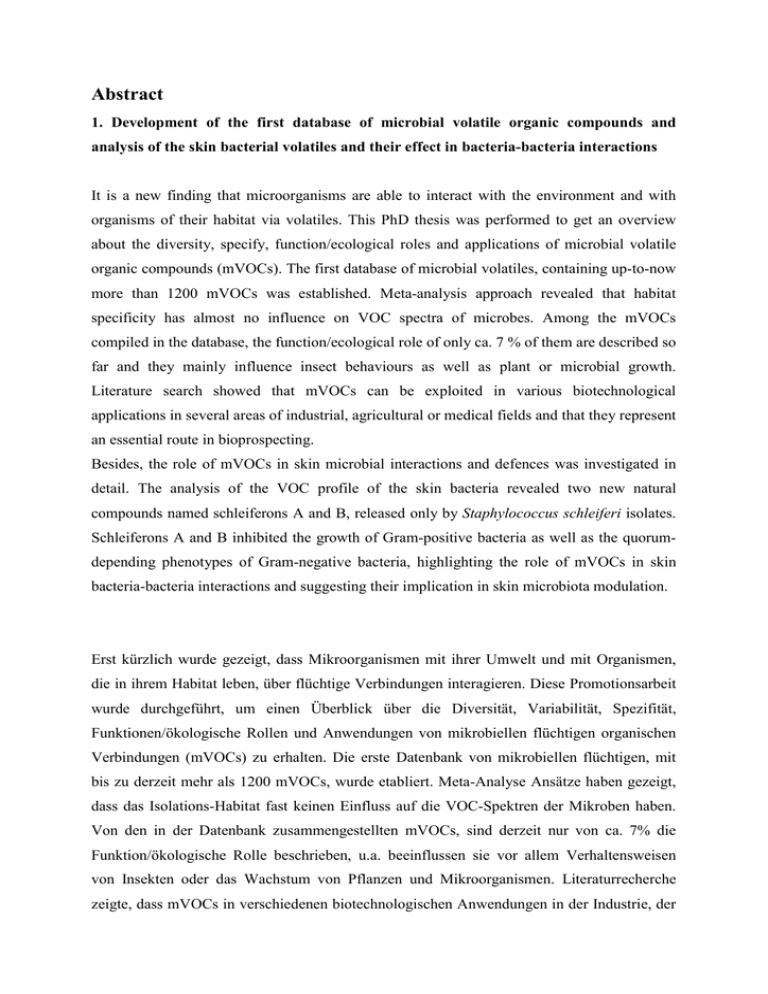deutsch und englisch
Werbung

Abstract 1. Development of the first database of microbial volatile organic compounds and analysis of the skin bacterial volatiles and their effect in bacteria-bacteria interactions It is a new finding that microorganisms are able to interact with the environment and with organisms of their habitat via volatiles. This PhD thesis was performed to get an overview about the diversity, specify, function/ecological roles and applications of microbial volatile organic compounds (mVOCs). The first database of microbial volatiles, containing up-to-now more than 1200 mVOCs was established. Meta-analysis approach revealed that habitat specificity has almost no influence on VOC spectra of microbes. Among the mVOCs compiled in the database, the function/ecological role of only ca. 7 % of them are described so far and they mainly influence insect behaviours as well as plant or microbial growth. Literature search showed that mVOCs can be exploited in various biotechnological applications in several areas of industrial, agricultural or medical fields and that they represent an essential route in bioprospecting. Besides, the role of mVOCs in skin microbial interactions and defences was investigated in detail. The analysis of the VOC profile of the skin bacteria revealed two new natural compounds named schleiferons A and B, released only by Staphylococcus schleiferi isolates. Schleiferons A and B inhibited the growth of Gram-positive bacteria as well as the quorumdepending phenotypes of Gram-negative bacteria, highlighting the role of mVOCs in skin bacteria-bacteria interactions and suggesting their implication in skin microbiota modulation. Erst kürzlich wurde gezeigt, dass Mikroorganismen mit ihrer Umwelt und mit Organismen, die in ihrem Habitat leben, über flüchtige Verbindungen interagieren. Diese Promotionsarbeit wurde durchgeführt, um einen Überblick über die Diversität, Variabilität, Spezifität, Funktionen/ökologische Rollen und Anwendungen von mikrobiellen flüchtigen organischen Verbindungen (mVOCs) zu erhalten. Die erste Datenbank von mikrobiellen flüchtigen, mit bis zu derzeit mehr als 1200 mVOCs, wurde etabliert. Meta-Analyse Ansätze haben gezeigt, dass das Isolations-Habitat fast keinen Einfluss auf die VOC-Spektren der Mikroben haben. Von den in der Datenbank zusammengestellten mVOCs, sind derzeit nur von ca. 7% die Funktion/ökologische Rolle beschrieben, u.a. beeinflussen sie vor allem Verhaltensweisen von Insekten oder das Wachstum von Pflanzen und Mikroorganismen. Literaturrecherche zeigte, dass mVOCs in verschiedenen biotechnologischen Anwendungen in der Industrie, der Landwirtschaft oder medizinischen Bereichen genutzt werden, und dass sie einen vielversprechende Quelle für neue biologisch aktive Naturstoffe sind. Detailliert wurde die Rolle von mVOCs in Interaktionen von auf der Haut lebenden Bakterien untersucht. Im Zuge der Analysen dieser VOC-Profile konnten zwei neue Naturstoffe, genannt Schleiferon A und B, aus Staphylococcus schleiferi isoliert werden. Schleiferon A und B hemmen das Wachstum von Gram-positiven Bakterien sowie die Quorum-sensing Phänotypen von Gram-negativen Bakterien. Diese Ergebnisse unterstreichen die Rolle von mVOCs in Bakterien-Gemeinschaften der Haut und ihrer Modulation.